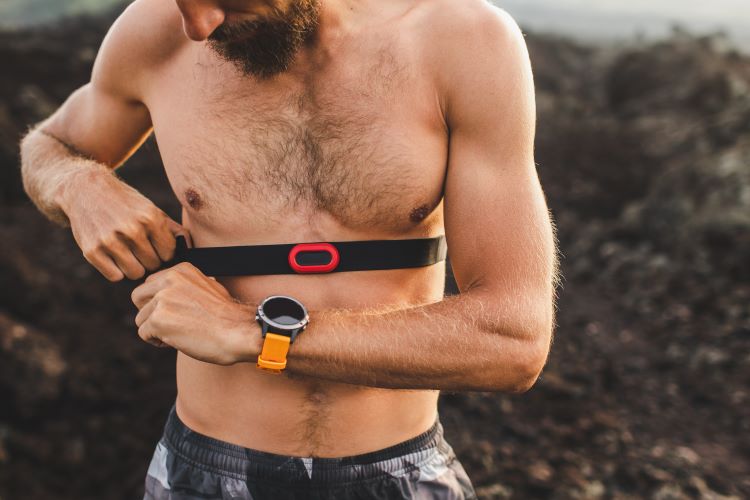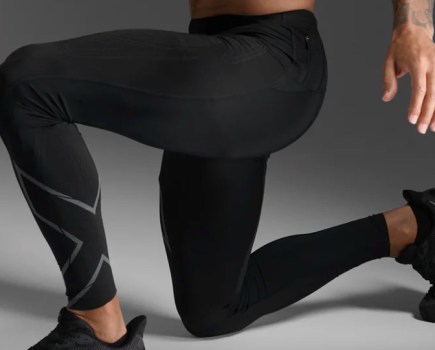View your vitals for more measured, focused training with our pick of the best heart rate monitors.
Want to take your fitness – and your wellness – to the next level? Whether you’re heading out for a run or using one of the best rowing machines at home, if you’re looking to get more out of your workouts it might be time to start tracking your health metrics. Using one of the best heart rate monitor is a great place to start.
Heart rate tracking can help you optimise your training time, be smarter with your recovery and ward off injury and over-exertion.
Plenty of fitness watches now track your heart rate BPM (beats per minute) from your wrist, but those tend not to be the most accurate. If you want reliable heart rate data to optimise your training, you really should be looking at a dedicated heart rate monitor.
Why you can trust Men’s Fitness
We spend hours testing every product or service we review, so you can be sure you’re buying the best. Find out more about how we test. Our team of reviewers includes experienced product testers, PTs, nutritionists and fitness writers – as well as the core MF team – who know exactly what sets the best products apart from the rest. These heart rate monitors were tested by experienced run kit tester Kieran Alger and MF cycling expert Laurence McJannet.
This is the best heart rate monitor
The heart rate monitor playing field is a very competitive one, but the Garmin HRM-Pro Plus comes out on top due to its overall reliability, ease of use and standalone usability. Its running dynamics are second to none, too (as long as you have a Garmin smartwatch).
Other heart rate monitor recommendations
| Best for accuracy | The Polar H10 might not offer quite the same amount of tracking and compatibility as some of its rivals, but it has them all beat in terms of pure accuracy. So if precise measurements are top of your shopping criteria above all else, look no further. |
| Best for swimming and multi-sports | The Polar Verity Sense is one of the least intrusive monitors on this list as you can wear it on either your forearm, bicep, or even on your swimming goggles (as long as you can ensure it has contact with your temple). |
| Best for flexibility | For ultimate flexibility, you’ve got to choose the Myzone MZ-Switch. With this monitor, you don’t need to choose between chest mounts or arm mounts, because this device can do both! |
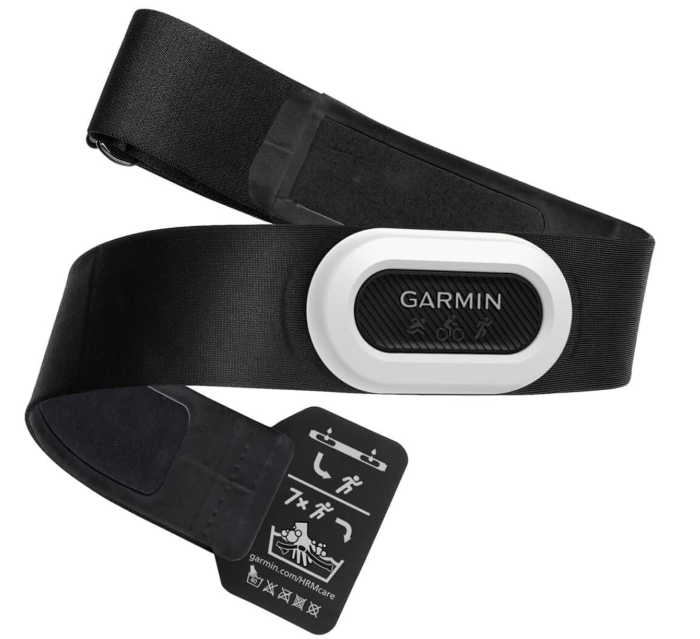
1. Garmin HRM-Pro Plus
Men’s Fitness verdict
The best heart rate monitor we tested, the Garmin HRM-Pro plus offers a wealth of multisport insights for competitive triathletes.- Good accuracy
- Running, cycling and swimming insights
- Not rechargable
- Expensive
| Weight | 1.8oz (52g) |
| Strap | 23.5in-56in (60cm-142cm) |
| Battery | CR2032, 360 hours |
| Features | Bluetooth and ANT+ connectivity / multisport dynamics (requires compatible Garmin smartwatch) / stand-alone activity monitoring |
| Water rating | 5ATM |
The Garmin HRM-Pro Plus features a small, lightweight sensor module that fits within the width of a soft, comfortable strap, making it – in my opinion – one of the less intrusive chest straps to wear for longer training sessions.
It runs on traditional watch batteries rather than rechargeables but will give you an hour training a day for a year before it runs out. It almost matches the Polar H10 for accuracy but outsmarts its rival with additional multi-sport dynamics, particularly running, making it an ideal choice for triathletes.
Connectivity is impressive too with three concurrent Bluetooth connections plus unlimited ANT+ connections.
- Read our full Garmin HRM-Pro Plus review
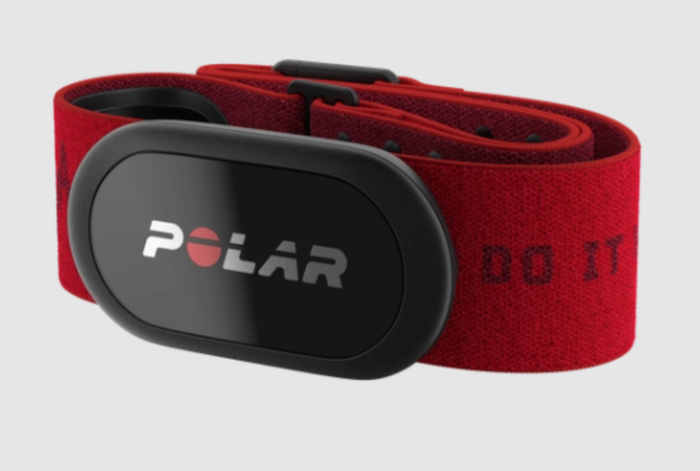
2. Polar H10
Men’s Fitness verdict
A hugely reliable heart rate monitor, the Polar H10 eschews tracking extras for accuracy and dependability.- Best for accuracy
- Excellent battery life
- No tracking extras
- Not rechargable
| Weight | 2.1oz (60g) |
| Strap | 22.8in-27.9in (58cm-71cm) / 26.3in-37.4in (67cm-95cm) |
| Battery | 3V lithium, 400 hours |
| Features | Bluetooth and ANT+ connectivity / 6 strap colors |
| Water rating | WR30 |
The Polar H10 sets the standard as far as accuracy and reliability are concerned – it literally never misses a beat. I found it to be fairly light and comfortable too, with a soft strap, ergonomic design and no-fuss quick-release clip for easy removal.
Polar has also gone with watch batteries over rechargeable ones, but you’ll get 400 hours run time before you need to change them. Its Bluetooth and ANT+ connectivity plays nicely with various watch brands, and you’ll probably want to connect because the unit can only store one workout at a time.
If running dynamics aren’t your thing and you just want accurate tracking, you can’t go wrong with the Polar H10.
- Read our full Polar H10 review
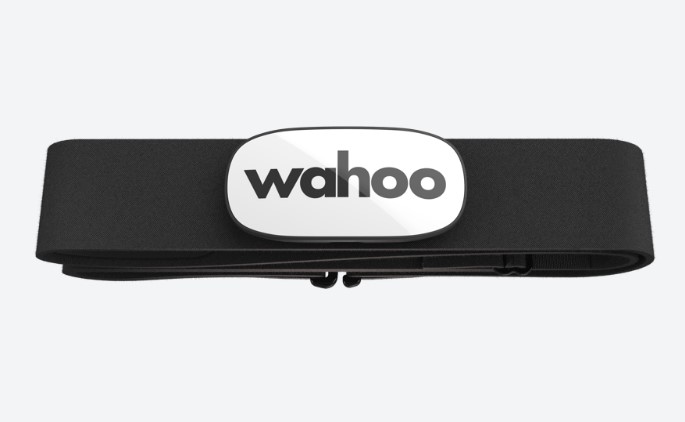
3. Wahoo TRACKR Heart Rate
Men’s Fitness verdict
The Wahoo TRACKR Heart Rate is an excellent value, lightweight heart rate monitor with great connectivity, which is now rechargeable too.- Highly accurate tracking
- Good connectivity
- Light weight
- Not waterproof
- No built-in memory
| Weight | 1.4oz (39g) with strap |
| Strap | 27in-36in (68cm-91cm) |
| Battery | Rechargeable, 100 hours |
| Features | 3x Bluetooth and ANT+ connectivity |
| Water rating | IPX7 |
The Wahoo TRACKR Heart Rate improves on its predecessor the TICKR X in almost every way. Rather than using CR2032 coin cell batteries, it now has a built-in rechargeable power source, giving you 100 hours performance on each charge. The weight has dropped from an already respectable 48g to an impressive 39g and the strap is comfier and more robust, and will now fit up to 50in / 127cm chests as well.
Like the TICKR X, the TRACKR Heart Rate matches the HRM-Pro Plus with its connectivity options too – which allowed me to run three simultaneous Bluetooth connections, as well as ANT+. I appreciated its LED feedback, too, which lets you know battery and pairing status.
Wahoo’s new monitor lives up to its name performance-wise too. In my tests, in-activity tracking accuracy proved exceptional, and you can access max heart rate, average heart rate and total calories in the activity summary in the Wahoo App, with heart rate variability (HRV) available with compatible apps.
Where it can’t compete is waterproofing – it’s only rated as IPX7 so won’t cope with any water-based workouts. And the only feature missing from the TICKR X is the in-build memory, so you’ll need to pair it to your device pre-workout. But with pairing simple and intuitive I’d say that’s by no means a deal breaker. In my opinion USB-C charging is a more valuable feature.

4. Polar Verity Sense
Men’s Fitness verdict
If you want an alternative to chest-strap heart rate monitors, you can’t go wrong with the optical Polar Verity Sense.- Comfortable alternative to a chest strap
- Good accuracy for an optical sensor
- Fiddly to use on the move
- Charging cradle is easy to lose
| Weight | 0.4oz (12g) |
| Strap | 9.1in-12.6in (23cm-32cm) |
| Battery | rechargeable, 30 hours |
| Features | Bluetooth and ANT+ connectivity / goggle strap clip / 16mb memory / 150m broadcast range |
| Water rating | WR50 |
The Polar Verity Sense is an optical heart rate tracker that’s a reliable alternative if chest straps aren’t your thing. It’s another good option for triathletes too, as it can be worn on your forearm, bicep and even goggle straps to track your BPM from your temples in the water.
You get a USB-chargeable battery giving you up to 30 hours run time, and a staggering broadcast range of up to 150m from its ANT+ and double Bluetooth connections. It can store up to 600 hours of workout data, too, so works well as a standalone device.
- Read our full Polar Verity Sense review
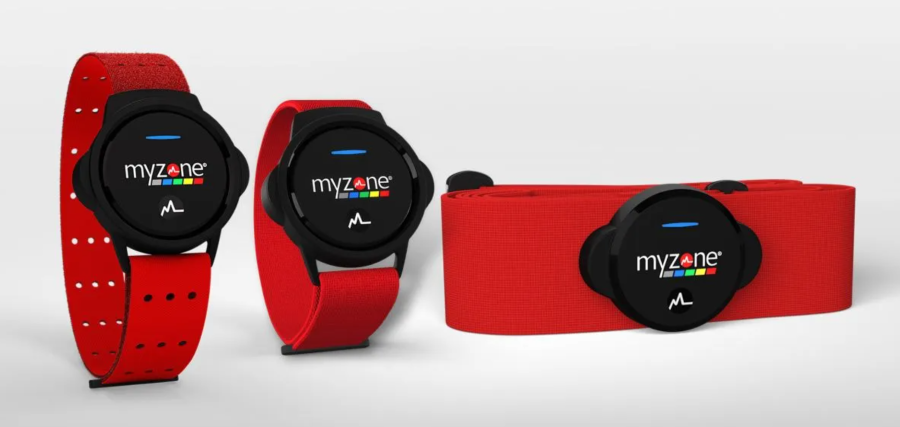
5. Myzone MZ-Switch
Men’s Fitness verdict
The Myzone MZ-Switch is the only heart rate monitor on test to provide EGC and optical monitoring, so you can wear it on your chest, arm or wrist.- Excellent versatility for different workouts
- Adds a gaming element to sessions
- Expensive
| Weight | 0.6oz (17g) |
| Strap | 21.3in-27.6in / 24.4in-34.6in / 27.6in-40.1in |
| Battery | Rechargeable, up to 6 months |
| Features | Arm, chest and wrist straps / stores 36 hours of exercise data / Bluetooth and ANT+ connectivity |
| Water rating | WR10 |
As the world’s first combined ECG-style chest strap and optical arm strap, the Myzone MZ-Switch is an extremely flexible option. You can move it from chest to forearm, bicep or wrist to suit your workout, which I found to be a big positive. It will cope with anything from vigorous HIIT sessions and lifting to running, cycling and open water swims with no problem.
You get 35 hours battery in time in optical mode, but you can quadruple that by using it as an ECG monitor. Indicators tell you what zone you’re in and if you’re the competitive type you can join the Myzone community and get effort points for all your workouts and propel you up the leaderboard.
Data storage and Bluetooth/ANT+ connectivity round out this flexible but pricey package.
- Read our full Myzone MZ-Switch review
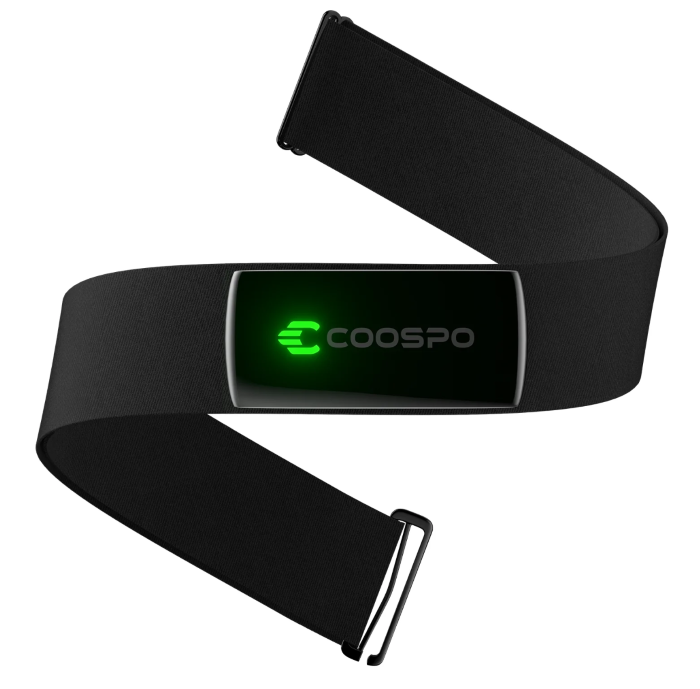
6. Coospo Realzone H9Z
Men’s Fitness verdict
If you’re shopping on a strict budget, the Coospo Realzone H9Z is a great option. It does the basics to a high standard, but can’t offer much in the way of frills. Overall, a solid, reliable device.- Rechargeable battery
- Excellent value
- Tracking limited to BPM
- No built-in memory
| Weight | 1.5oz (43g) |
| Strap | 25in-36in (63.5cm-91.4cm) |
| Battery | Rechargeable 70mAh lithium battery, 50 hours |
| Features | 5-color LED / pairing alert / Bluetooth and ANT+ connectivity |
| Water rating | IPX7 |
The Realzone H9Z builds on the simplicity of its even cheaper sibling, the H808S, but swaps the coin battery for a more user-friendly rechargeable one. Once again, I found that tracking was on a par with much more expensive options. Plus, an IPX7 rating ensures a good degree of moisture protection.
A five-color LED lets you know what zone you’re in and an audible beep tells you when it’s paired to your training device. It may be a no-frills option, but it just gets on with providing you with the reliable data you need, and all for a bargain price.
- Read our full Coospo Realzone H9Z review
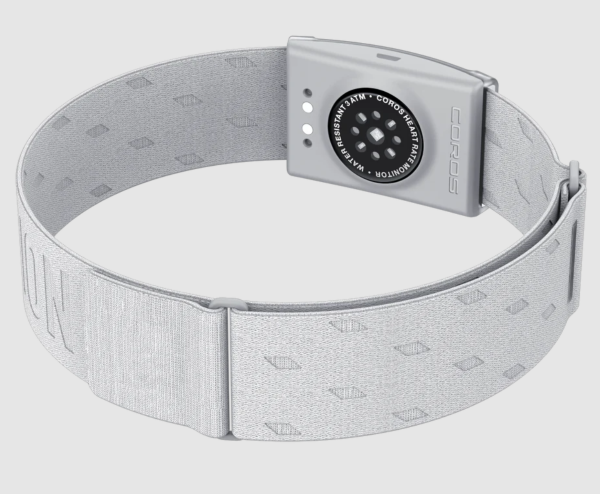
7. Coros Heart Rate Monitor
Men’s Fitness verdict
Arguably less invasive thanks to being arm-mounted rather than chest-mounted, the Coros HRM outshines smartwatch alternatives.- Automatic wear detection
- Reliable tracking
- Light and comfortable
- No off switch
- No workout storage
| Weight | 0.7oz (19g) |
| Strap | 7in-12.5in (18cm-32cm) |
| Battery | Rechargeable 55mAh lithium battery, 38 hours |
| Features | Auto-wear detection / Bluetooth connectivity |
| Water rating | 3ATM |
Coros’ sleek bicep-mounted unit is well worth considering if you’re looking for an alternative to the traditional chest strap. It doesn’t have all the smart metrics of pricier units, but in my opinion, it will match them beat for beat where heart rate tracking is concerned.
Charging via USB gives you 38 hours of operation, meaning you should only need to recharge once a month. It auto activates as soon as you slip it on, too, which I found really useful as I didn’t need to manually switch it on or pair it with my other devices.
- Read our full Coros Heart Rate Monitor review
Wrist vs chest strap heart rate monitors
Heart rate monitors fall into two categories – EGC chest straps that measure your heart rate close to its source and optical sensor arm straps. The latter use the same blood-flow reading tech as the sensors in your watch, but they can be moved around the body for improved accuracy and convenience during different activities.
Optical heart rate monitors use green lights on the underside of the device, which your blood reflects to measure how fast it’s flowing through your veins and therefore how fast your heart is beating. ECG heart rate monitors are based on medical-grade electrocardiogram technology and use electrodes pressed onto your skin to log your heart’s electrical activity.
Logging your heart’s electrical pulses is more accurate and immediate than measuring reflected light, which is why serious athletes tend to prefer chest strap heart rate monitors for training and competition. However, there are now some trackers that offer both ECG and optical monitoring for maximum versatility. Also, more and more watch manufacturers are starting to use ECG monitors to measure heart rate.
What makes a good heart rate monitor?
So apart from monitor type, what else should you consider when buying a heart rate monitor? However you plan on using your heart rate monitor, there are three basic things you should consider:
Comfort
The last thing you want if you’re competing in an endurance event is a strap that digs or rolls into your skin, or a sensor that presses into your solar plexus. Likewise, arm straps that chafe or connectors that rub will also be unwelcome distractions during your all-out heroic efforts. So if possible, try before you buy.
Accuracy
In some cases you might need to trade some accuracy for comfort and convenience. For example, during a triathlon race an arm strap might make for easier transitions, though the optical data might not be quite as accurate. Or a chest strap might feel to restrictive during the exertions of an dynamic HIIT session. But if accurate heart rate data is key to your training regime, you need to be using an ECG monitor.
Connectivity
Think about how you’ll be using your heart rate monitor, and how that might change in the future. Is it likely you’ll want to pair it with other gear like a GPS watch, fitness app, cycle computer, gym equipment or training services like Peloton or Zwift? If so, you’ll need ANT+ and Bluetooth connectivity, and possibly multiple concurrent connections.
Water resistance
How waterproof do you need your heart rate monitor to be? Sitting next to the skin, most tend to be at least IPX7 rated, meaning they are sweatproof but not waterproof. Others are intended for swimming and will either have an ATM or ‘atmospheres’ pressure ratings (5ATM is equal to about 50m) or a straightforward WR rating (WR30 means waterproof to 30m, for example).
Beyond that, some of the best chest straps now have motion sensors and track more than just heart rate. They offer additional insights for things like running form or cycling cadence. Could these be useful in your fitness development?

